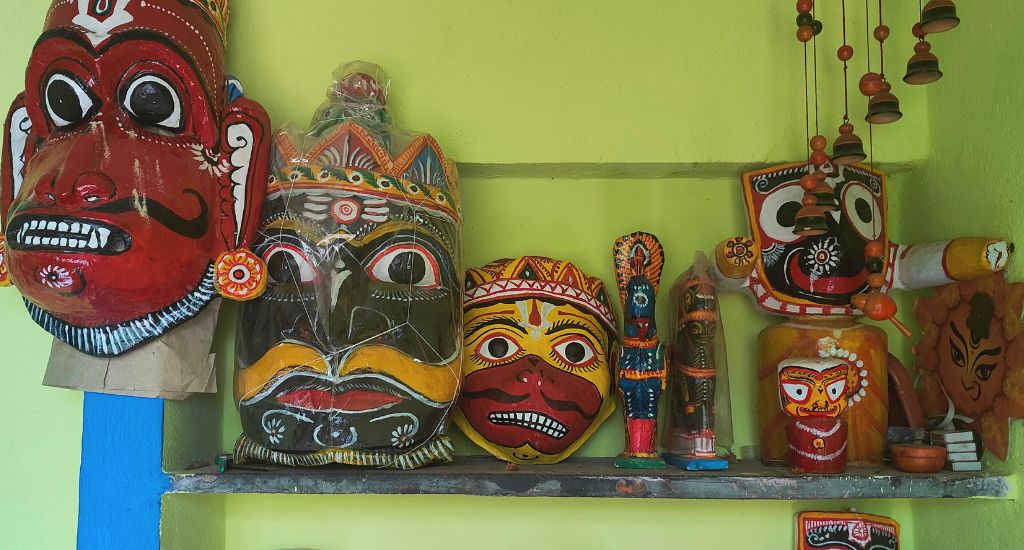
Curtains down for Odisha dolls made of cow dung?
Though no way as fancy as the dolls that adorn upscale stores, Karadagadia village has carved out a niche for its toys made of cow dung, paper and flowers.

Though no way as fancy as the dolls that adorn upscale stores, Karadagadia village has carved out a niche for its toys made of cow dung, paper and flowers.
You will not find these dolls in the fanciest stores or under the toy section of popular e-commerce websites. Nor do they come in shining attire or fancy packaging.
Yet, the dolls made in Karadagadia village – some 70 km from the capital city of Bhubaneswar in Odisha – have made a name for themselves.
Exquisitely hand-crafted and painted painstakingly, the unique selling points of the dolls are that they are economical and ecologically friendly.
They after all are made from cow dung, discarded paper, tamarind seeds and colourful flowers that otherwise would have withered away over time.

For all practical purposes, the dolls of Karadagadia make the best use of waste.
What goes into making the dolls are locally available. They are also necessarily biodegradable.
Also Read | Bengal’s traditional shellac dolls face lacklustre future
Making the dolls runs deep in the village. To start with, the cow dung is marinated into a fine paste. If the cow dung is thicker in texture, it is mixed with charred wood remains. If the texture is naturally thin, then it is mixed with glue to bring it to an adequate proportion of thickness. This glue is also prepared by using tamarind seeds.
The fine paste is then moulded into various shapes – birds, elephants, horses, a horse rider, a girl, a boy, a king and a queen. They also make different kinds of masks and idols for temples.
Once moulded, the skeletal structures are allowed to dry for several days before they are adorned with embellishments.

The bare structures are plastered with paper coated with a layer of naturally prepared glue. The dolls are then painted and ready to be sold.
The process requires skill, but then Karadagadia has plenty of it. Almost every family has a doll maker, with villagers – young or old – adept at creating those cheap but magical dolls.
Manjulata Mohapatra, now 60, started making the dolls at eight. She had learnt the art from her parents. While her parents excelled in the art of making wooden toys, she sharpened her own skills of making dolls out of cow dung after her marriage. Her husband also happens to be a doll maker.
Also Read | Toy makers adapt to markets, add color to fading industry
Manjulata’s two children have also picked up the skill.
“There is no age to learn how to make these dolls. My children started learning it when they were barely six. We divide the work and everybody gets involved in the process. This is our only source of income,” Manjulata said.

The family makes and sells these dolls that could cost anywhere between Rs 10 to over Rs 8000. “The small birds or animals don’t cost much. But at times we make life-sized figures too. They are mostly sold at fairs. They fetch us a good amount,” she added.
She remembers how almost 40 years ago; her husband went around from village to village on his cycle selling these dolls.
Sadly though, the Karadagadia dolls have fallen on bad times. With high-end modern toys catching the popular imagination, the sale of toys made of cow dung is now mostly restricted to seasonal fairs and in the vicinity of temples.
The doll makers of Karadagadia have also somehow lost out on government patronage.
The famous temple and water spring of Atri are barely a kilometre away from the village. While big hoardings of Odisha tourism department publicise them, the dolls of Karadagadia find no mention in them.
The likes of Manjulata believe their art could flourish if the authorities paid them some attention too.

“Some support could boost our traditional craft. It would ensure the art form survives and does not vanish,” explained Reenarani Mohapatra.
Also Read | Doll makers of Bengal face bleak prospects
For the time being though, the art of making dolls in Karadagadia is dying a slow death.
The lead image at the top shows the forgotten cow dung dolls of Odisha on display. (Photo by Aishwarya Mohanty)
Aishwarya Mohanty is an independent journalist based in Odisha. She reports on the intersection of gender, social justice, rural issues and the environment. She is also a Rural Media Fellow powered by Youth Hub.